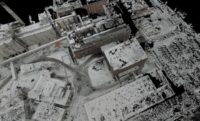

Most remodeling contractors still generate building information models for an existing structure from original construction drawings, and the inevitable deviations end up as field surprises that result in costly change orders and delays. Emerging 3D laser scanners streamline the workflow by taking the unknowns out of the equation.
"Laser scanning is the truth serum that fits into BIM," says Ken Smerz, president of Precision 3D Scanning, Chandler, Ariz., a 3D laser-scanning service provider. BIM models, he says, still largely show details built at right angles. "If you've been in construction for more than 10 minutes, you know that is not how it is. With laser scanning, you get the most accurate BIM possible," he explains.
However, industry buy-in has been slow. Consensus is that, at most, only 2% to 5% of projects use laser scanning, and the majority of them are remodeling jobs rather than new construction. As prices for scanning equipment fall and capabilities improve, demand has crept up. For the most part, owners and architects are driving the movement, asking often-wary contractors to scan before they plan.
"There is resistance from contractors because scanning eliminates some of the unknowns, and in doing so, potentially reduces the number of change orders, which some contractors count on when bidding a project," says Carlos Velazquez, CEO and founder of Epic Scan Ltd., Medford, Ore. "It's an unfortunate practice to low-bid projects and drive up the cost." Contractors that want to differentiate themselves are slowly coming around to the technology and beginning to see its advantages, experts say.
While remodelers scan prior to work, contractors working on new construction scan afterward to ensure accurate as-built drawings. Either way, the result, users say, is improved quality, monitoring and fit.
McCarthy Building Cos. Inc., St. Louis, uses laser scanning to document conditions on renovations or additions and maintain schedules, and Turner Construction sees it as key in hospital work. "We won't do hospital renovations without laser scanning anymore," says Mario Mazzi, a superintendent in Turner's Sacramento, Calif., office. It minimizes disruptions to hospital services and eliminates unknowns, he adds. "We have far fewer change orders as a result."
Pepper Construction Group, Chicago, is among a small group of contractors that offers 3D laser scanning in-house. The company invested roughly $80,000 in a Trimble CX 3D scanner in late 2011. "Right now, we're using the scanner every other week at a minimum," says Kevin Bredeson, Pepper's director of virtual construction. "Our projections had been to pay off the scanner in less than three years, but at this pace, we're going to pay it off in two years easily."
Many contractors have yet to tap into the savings that the process offers. Realizing scanning's potential will require industry education, which will take time, Smerz says.


Post a comment to this article
Report Abusive Comment